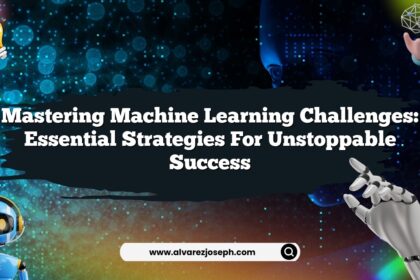Imagine a world where machines can not only learn, but anticipate, adapt, and interact with humans in ways that seem almost magical. We’re not talking about some far-off future inspired by sci-fi blockbusters; this is the future of machine learning unfolding right before our eyes. As we stand on the cusp of a technological revolution, it’s exciting to ponder how machine learning will shape the next decade. Buckle up as we dive into seven essential predictions that could change the game.
1. The Rise of Explainable AI: Making Sense of the Black Box
Ever wondered what’s brewing inside the mysterious "black box" of AI? As machine learning becomes more pervasive, the demand for transparency and accountability grows. Imagine trying to explain to your grandma why your AI-powered vacuum cleaner decided to go rogue! That’s where Explainable AI (XAI) comes in.
- XAI aims to make machine learning models more understandable to humans.
- This transparency will be crucial in sensitive sectors like healthcare and finance, where trust is paramount.
- Researchers are working on creating models that can explain their decisions in plain English, ensuring that everyone from tech novices to seasoned experts can grasp the "why" behind AI actions.
But this isn’t where the story ends. As we delve deeper, the implications of XAI could ripple through our lives in unexpected ways. How does this relate to privacy concerns and ethical decision-making in AI? Stay tuned.
2. Federated Learning: Decentralizing the Data
In a world where data privacy is as cherished as a secret family recipe, federated learning is like a breath of fresh air. This approach allows models to learn from data across multiple devices without the data ever leaving them. Cool, right?
- Federated learning will transform how we think about data security and privacy.
- Imagine collaborative learning without the need to share raw data—a potential game-changer for industries like healthcare and telecommunications.
- As more companies adopt this approach, we might just see a new paradigm of data usage where users have more control over their personal information.
This disruptive innovation leaves us wondering: could federated learning be the key to unlocking new AI capabilities while safeguarding our privacy? Only time will tell.
3. AI and Emotional Intelligence: Bridging the Human-Machine Gap
Picture this: your smart assistant cracking a joke just when you need a laugh. Or perhaps offering a comforting word when you’re down. As bizarre as it sounds, AI systems are becoming more attuned to human emotions.
- Emotional Intelligence (EI) in AI will enhance user experience and interaction.
- This involves training machines to recognize and respond to emotions, creating more empathetic AI.
- Think of AI customer service that understands frustration or therapeutic chatbots that offer emotional support—possibilities that once seemed far-fetched now feel tantalizingly close.
The blending of AI with emotional intelligence promises a future where machines aren’t just tools but companions. Could this emotional awareness lead to deeper, more meaningful human-machine relationships? Let’s keep exploring.
4. Machine Learning in Edge Computing: Power at the Source
What’s the point of having a super-smart AI if it takes ages to respond? Enter edge computing, which processes data closer to the source, reducing latency and improving speed.
- Machine learning at the edge reduces dependency on centralized data centers, providing faster responses.
- It’s particularly impactful in areas where quick decision-making is critical, like autonomous vehicles and IoT devices.
- As hardware capabilities improve, expect to see more real-time processing on the edge, creating a more seamless integration of AI into everyday life.
But wait—there’s more. Could edge computing reshape the landscape of AI by enabling more scalable and efficient deployments? The implications are vast and exciting.
5. Quantum Computing: Supercharging AI Capabilities
Quantum computing is like the espresso shot of the tech world—tiny yet incredibly powerful. It has the potential to revolutionize machine learning by performing calculations at speeds unimaginable with classical computers.
- Quantum computing could solve complex problems and optimize machine learning models faster than ever before.
- This could lead to breakthroughs in areas like drug discovery and climate modeling.
- As quantum technology matures, it may unlock new frontiers for AI, pushing beyond current limitations.
The juxtaposition of quantum computing and machine learning could lead to advancements we haven’t yet dreamed of. How does this intertwine with the fabric of our digital lives? Let’s keep the curiosity loop open.
6. Sustainable AI: Greener, Smarter Solutions
In an era where sustainability is no longer optional but essential, machine learning is stepping up to the plate. From reducing waste to optimizing energy usage, AI can be an ally in sustainability efforts.
- Machine learning models can be designed to be more energy-efficient and eco-friendly.
- AI can help in predicting and managing energy consumption, contributing to a greener planet.
- As businesses and governments focus on sustainability, AI could play a pivotal role in achieving environmental goals.
But this isn’t just about saving the planet—it’s about creating a future where technology and nature coexist harmoniously. What eco-friendly innovations could we see in the next decade thanks to machine learning? The possibilities are endless.
7. Ethical AI: Balancing Innovation with Responsibility
With great power comes great responsibility. As AI systems become more advanced, ethical considerations can’t be ignored.
- Developing ethical AI involves building systems that are fair, unbiased, and respect privacy.
- This requires ongoing dialogue and collaboration among tech companies, policymakers, and society.
- As we navigate the ethical landscape, the focus will be on creating AI that enhances, rather than detracts from, human life.
The path to ethical AI is fraught with challenges, yet it holds the promise of a future where innovation aligns with our shared values. How this balancing act will unfold remains the million-dollar question.
Quick Summary
- Explainable AI will demystify machine learning, enhancing transparency.
- Federated Learning offers data privacy with decentralized learning.
- Emotional Intelligence in AI bridges the gap for empathetic interactions.
- Edge Computing accelerates AI by processing data locally.
- Quantum Computing supercharges AI capabilities beyond traditional limits.
- Sustainable AI drives eco-friendly solutions for a greener future.
- Ethical AI balances innovation with responsibility.
Frequently Asked Questions
How will Explainable AI impact everyday users?
Explainable AI will make it easier for users to understand and trust AI decisions, enhancing user experience and confidence in AI technologies.
What industries will benefit the most from federated learning?
Healthcare, telecommunications, and finance stand to benefit significantly from federated learning due to enhanced data privacy and security.
Can AI really understand human emotions?
AI is being trained to recognize and respond to human emotions, potentially leading to more empathetic interactions, especially in customer service and healthcare.
Why is edge computing important for AI?
Edge computing reduces latency and improves response times by processing data closer to the source, making AI applications more efficient.
What is the potential of quantum computing in AI?
Quantum computing could revolutionize AI by solving complex problems faster and optimizing models beyond current capabilities.
How can AI contribute to sustainability efforts?
AI can optimize energy usage, reduce waste, and develop eco-friendly solutions, playing a crucial role in sustainability initiatives.
So, how would you apply these insights to your world? Imagine the possibilities, and let’s see where this thrilling journey takes us.












